- Главная
- Разное
- Бизнес и предпринимательство
- Образование
- Развлечения
- Государство
- Спорт
- Графика
- Культурология
- Еда и кулинария
- Лингвистика
- Религиоведение
- Черчение
- Физкультура
- ИЗО
- Психология
- Социология
- Английский язык
- Астрономия
- Алгебра
- Биология
- География
- Геометрия
- Детские презентации
- Информатика
- История
- Литература
- Маркетинг
- Математика
- Медицина
- Менеджмент
- Музыка
- МХК
- Немецкий язык
- ОБЖ
- Обществознание
- Окружающий мир
- Педагогика
- Русский язык
- Технология
- Физика
- Философия
- Химия
- Шаблоны, картинки для презентаций
- Экология
- Экономика
- Юриспруденция
Что такое findslide.org?
FindSlide.org - это сайт презентаций, докладов, шаблонов в формате PowerPoint.
Обратная связь
Email: Нажмите что бы посмотреть
Презентация на тему Великие художники. И. Айвазовский
Содержание
- 2. Aivazovsky Ivan Konstantinovich. (1817-1900).The Marine-romantic artist, the
- 3. His father was a relatively well-educated man
- 4. The young boy's eager mind soaked up
- 5. Aivazovsky's student days in St. Petersburg coincided
- 6. In the autumn of 1836 Aivazovsky presented
- 7. During the period of 1840-1844 Aivazovsky, as
- 8. In 1844 Aivazovsky asked permission to return
- 9. By the mid-1840s Aivazovsky was already thinking
- 10. Towards the 1850s the romantic features in
- 11. Fate was kind to Aivazovsky, bestowing on
- 12. The description of the picture "The Ninth Wave"
- 13. "The Ninth Wave" - one of the
- 14. Скачать презентацию
- 15. Похожие презентации
Aivazovsky Ivan Konstantinovich. (1817-1900).The Marine-romantic artist, the master of Russian classical landscape transferring on a cloth beauty and power of sea elements. The author of battle pictures on themes of history of Russian military fleet. Veins
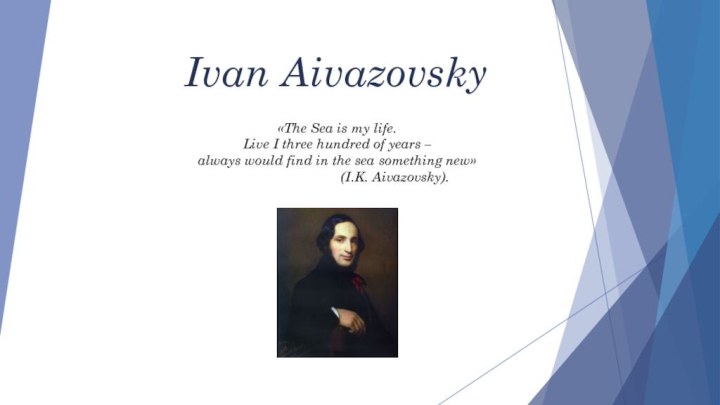
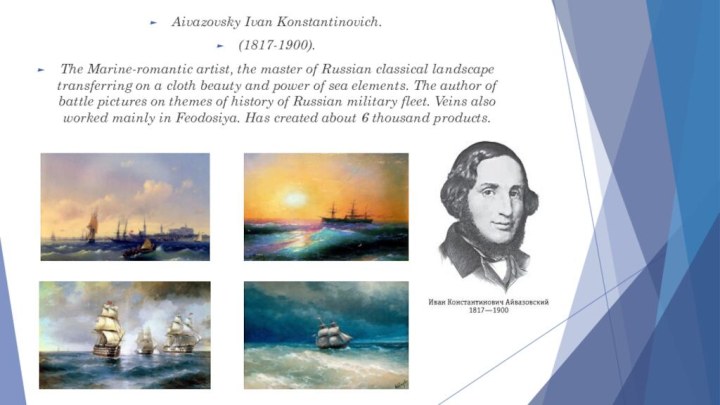

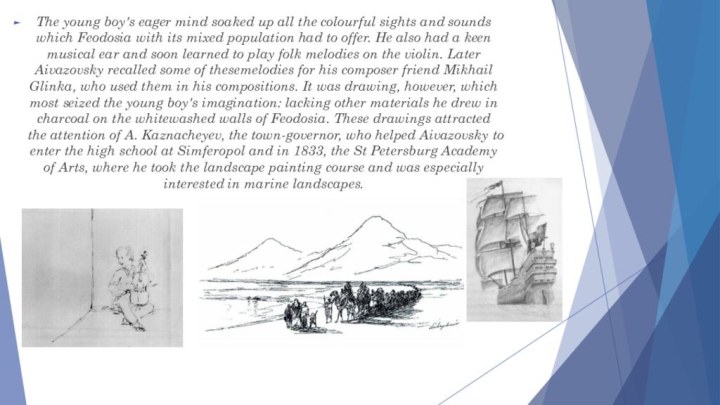
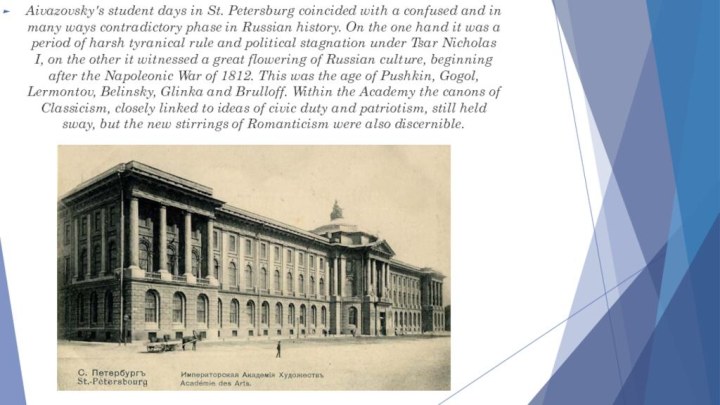
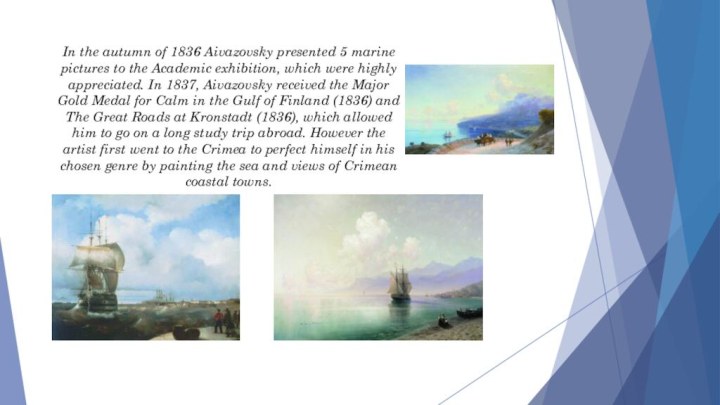

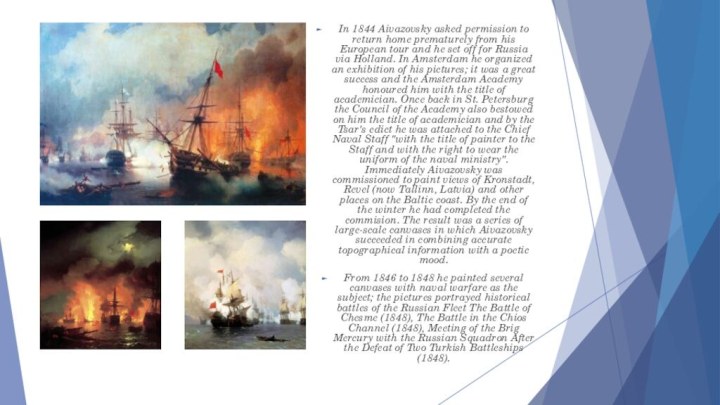
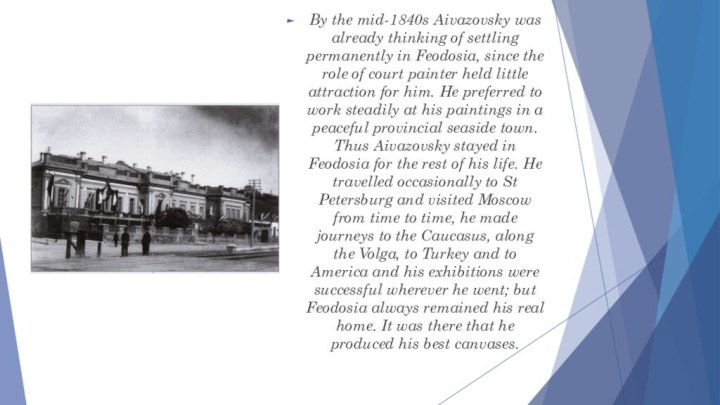



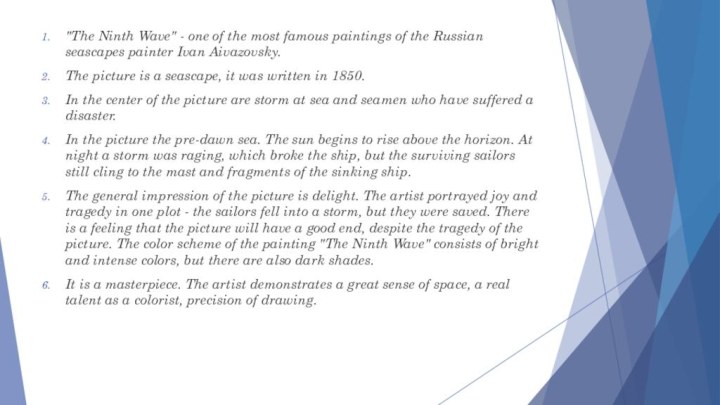

Слайд 3 His father was a relatively well-educated man who
knew several oriental languages, and who, though a trader
of small means, played a significant part in the commercial life of the town. Unfortunately the plague epidemic which hit Feodosia in 1812 wrecked his business, and when the future artist was born, the family had indeed fallen on hard times.Слайд 4 The young boy's eager mind soaked up all
the colourful sights and sounds which Feodosia with its
mixed population had to offer. He also had a keen musical ear and soon learned to play folk melodies on the violin. Later Aivazovsky recalled some of thesemelodies for his composer friend Mikhail Glinka, who used them in his compositions. It was drawing, however, which most seized the young boy's imagination: lacking other materials he drew in charcoal on the whitewashed walls of Feodosia. These drawings attracted the attention of A. Kaznacheyev, the town-governor, who helped Aivazovsky to enter the high school at Simferopol and in 1833, the St Petersburg Academy of Arts, where he took the landscape painting course and was especially interested in marine landscapes.Слайд 5 Aivazovsky's student days in St. Petersburg coincided with
a confused and in many ways contradictory phase in
Russian history. On the one hand it was a period of harsh tyranical rule and political stagnation under Tsar Nicholas I, on the other it witnessed a great flowering of Russian culture, beginning after the Napoleonic War of 1812. This was the age of Pushkin, Gogol, Lermontov, Belinsky, Glinka and Brulloff. Within the Academy the canons of Classicism, closely linked to ideas of civic duty and patriotism, still held sway, but the new stirrings of Romanticism were also discernible.
Слайд 6
In the autumn of 1836 Aivazovsky presented 5
marine pictures to the Academic exhibition, which were highly
appreciated. In 1837, Aivazovsky received the Major Gold Medal for Calm in the Gulf of Finland (1836) and The Great Roads at Kronstadt (1836), which allowed him to go on a long study trip abroad. However the artist first went to the Crimea to perfect himself in his chosen genre by painting the sea and views of Crimean coastal towns.Слайд 7 During the period of 1840-1844 Aivazovsky, as a
pensioner of the Academy of Arts, spent time in
Italy, traveled to Germany, France, Spain, and Holland. He worked much and had many exhibitions, meeting everywhere with success. He painted a lot of marine landscapes, which became very popular in Italy: The Bay of Naples by Moonlight (1842), Seashore. Calm. (1843), Kind on the Venetian lagoon (1841), Bay of Naples (1841). His works were highly appreciated by J.W.M. Turner, a prominent English landscape and marine painter. In the course of his work, Aivazovsky evolved his own method of depicting the motion of the sea – from memory, without preliminary sketches, limiting himself to rough pencil outlines. Aivazovsky’s phenomenal memory and romantic imagination allowed him to do all this with incomparable brilliance. The development of this new method reflected the spirit of the age, when the ever-increasing romantic tendencies put an artist's imagination to the front.The Bay of Naples by Moonlight (1842)
Kind on the Venetian lagoon (1841)
Слайд 8 In 1844 Aivazovsky asked permission to return home
prematurely from his European tour and he set off
for Russia via Holland. In Amsterdam he organized an exhibition of his pictures; it was a great success and the Amsterdam Academy honoured him with the title of academician. Once back in St. Petersburg the Council of the Academy also bestowed on him the title of academician and by the Tsar's edict he was attached to the Chief Naval Staff "with the title of painter to the Staff and with the right to wear the uniform of the naval ministry". Immediately Aivazovsky was commissioned to paint views of Kronstadt, Revel (now Tallinn, Latvia) and other places on the Baltic coast. By the end of the winter he had completed the commision. The result was a series of large-scale canvases in which Aivazovsky succeeded in combining accurate topographical information with a poetic mood.From 1846 to 1848 he painted several canvases with naval warfare as the subject; the pictures portrayed historical battles of the Russian Fleet The Battle of Chesme (1848), The Battle in the Chios Channel (1848), Meeting of the Brig Mercury with the Russian Squadron After the Defeat of Two Turkish Battleships (1848).
Слайд 9 By the mid-1840s Aivazovsky was already thinking of
settling permanently in Feodosia, since the role of court
painter held little attraction for him. He preferred to work steadily at his paintings in a peaceful provincial seaside town. Thus Aivazovsky stayed in Feodosia for the rest of his life. He travelled occasionally to St Petersburg and visited Moscow from time to time, he made journeys to the Caucasus, along the Volga, to Turkey and to America and his exhibitions were successful wherever he went; but Feodosia always remained his real home. It was there that he produced his best canvases.Слайд 10 Towards the 1850s the romantic features in Aivazovsky’s
work became increasingly pronounced. This can be seen quite
clearly in one of his best and most famous paintings The Ninth Wave (1850) and also in Moonlit Night (1849), The Sea. Koktebel. (1853), Storm (1851), Shipwreck (1854) and others.The process, which determined the development of Russian art in the second half of the 19th century, also affected Aivazovsky. A new and consistently realistic tendency appeared in his work, although the romantic features still remained. The artist's greatest achievement of this period is The Black Sea (1881), a picture showing the nature of the sea, eternally alive, always in motion. Other important pictures of the late years are Rainbow (1873), Shipwreck at rocks (1870s), Shipwreck (1876), The Billow (1889), The Mary Caught in a Storm (1892).
Слайд 11 Fate was kind to Aivazovsky, bestowing on him
a clear mind and rich soul. He worked all
his life in a congenial setting of his own choice; he received in his lifetime all the signs of official recognition which he deserved; his talent was universally acclaimed.From his home in Feodosia Aivazovsky worked for the good of its inhabitants and the development of the region, taking this role very seriously. He opened in Feodosia the first School of Arts (in 1865), then the Art Gallery (in 1889). He supplied the town with water from his own estate, began the first archaeological excavations in the region and built a historical museum. Finally, thanks to his efforts a commercial port was established at Feodosia and linked up to the railway network. By these and other deeds Aivazovsky earned the love and respect of the townspeople. To this day the principal sights of the town are his picture gallery and his grave near an ancient Armenian church.
Aivazovsky died on 19 April (2 May New Style) 1900, on the verge of the twentieth century. On easel there was a canvas with the unfinished picture "Explosion of the ship" he had begun that same day. On his tombstoneis written: "He was born mortal - has left on itself immortal memory".
Whatever lies ahead for Russian art there is no doubt that the creative legacy of Aivazovsky will always be a treasured part of its history.
Слайд 13 "The Ninth Wave" - one of the most
famous paintings of the Russian seascapes painter Ivan Aivazovsky.
The
picture is a seascape, it was written in 1850.In the center of the picture are storm at sea and seamen who have suffered a disaster.
In the picture the pre-dawn sea. The sun begins to rise above the horizon. At night a storm was raging, which broke the ship, but the surviving sailors still cling to the mast and fragments of the sinking ship.
The general impression of the picture is delight. The artist portrayed joy and tragedy in one plot - the sailors fell into a storm, but they were saved. There is a feeling that the picture will have a good end, despite the tragedy of the picture. The color scheme of the painting "The Ninth Wave" consists of bright and intense colors, but there are also dark shades.
It is a masterpiece. The artist demonstrates a great sense of space, a real talent as a colorist, precision of drawing.





























